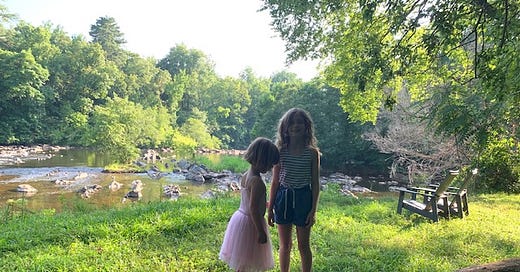Yesterday afternoon it began to thunder just after my neighbor David texted me about the weather. Hot as dammit, he said. We need rain bad, I agreed—to cool things down, and for the trees and gardens and the river. We texted back and forth as the thunder grew louder, then subsided. Rain chance 60% at 4 today, I said. Maybe we’ll get some then? Eventually the storm skirted around us, and we had to set our sights on Tuesday, when we have another good chance of rain.
It’s not a desperate drought situation here—not like in California, where the worst drought on record is contributing to deadly wildfires. But it’s been dry, and it’s also been above ninety degrees fifteen days in July (so far). I thought this would be a good opportunity to explain something about river pollution and why we couldn’t swim last weekend.
With any watershed, there are two big sources of pollution: point source, and nonpoint source.
Point source pollution happens when contamination can be traced back to a single source. So, this happens in the ocean when oil tankers spill. In rivers, this often happens when cities dump improperly-treated wastewater into the river. It also happens when factories dump pollutants into their wastewater without treating them, as well as when their equipment fails (which seems to happen a lot around here!) When companies aren’t held to a high standard (or punished for making mistakes), they will often do the fastest, easiest, cheapest thing (for them)—which means the river, and all the people and animals and plants that depend on the river, will suffer.
Nonpoint source pollution is any contamination that can’t be blamed on one source. This is what happens when it rains (or when snow melts in snowy places), and fertilizer, animal poop, sediment from improperly-managed construction and timbering sites, golf courses, and oil from roads and paved areas runs into the river. Even dirt from cleared land and eroded banks can be pollution—too much, and it clogs the gills of fish and makes it harder for aquatic plants to grow. In the Haw, nonpoint source pollution “no swim” alerts, like the one issued last weekend, are often the result of post-rain runoff from farms, golf courses, and plain old housing developments. The weekly swim guide released by the Haw River Assembly’s Riverkeepers is based on the level of e.coli bacteria, which is an indicator of overall river health.
So what does this have to do with it not raining? Isn’t the fact that pollution isn’t running into the river a silver lining for a hot, dry day (like today)? Unfortunately, drought conditions only make things worse! This is because once it finally rains, there will be a greater concentration of pollutants to wash into streams. There will be more oil on the roads, more fertilizer in the fields, more chemicals on people’s lawns. Droughts also contribute to erosion, a lower ability for soils to absorb rainfall, and a lower overall river level—which means whatever goes into the river is less diluted.
So, the river may be clear today (and Harriet and I do plan to splash in it), but after Tuesday, we could be back to a no-swim alert. This is really frustrating, but there are some important things you can do to help:
-Join the Haw River Assembly or your local river environmental group. Sign up for newsletters or follow your local environmental group on social media to find out about opportunities to volunteer.
-Safely clean up trash along rivers or roadways.
-Don’t use chemicals, pesticides, or fertilizer on your lawn or yard! In fact, turning your yard into a pollinator-friendly garden is easier for you and better for rivers and bees, birds, and butterflies (among other pollinators).
-Compost yard and garden waste (remember, a pile of leaves will feed the fireflies).
-Pick up dog/pet waste and flush it down the toilet (really!)
-Buy less new stuff, and don’t buy anything nonstick. Be aware of items treated with PFAS (limited, and against the law next year, in California), which are dangerous for rivers, watersheds, and drinking water.
-Don’t wash your car on a paved or hard-surface area—if you have to, wash it at a car wash that recycles water, or wash it in the yard.
-Never mow or clear brush right up to a river or stream—leave a buffer! This will reduce erosion, plus it’s an important home for many animals.
-Dispose of medicines, oils, and other waste properly.
-Eat less meat!
We’re signing up to volunteer as official riverkeepers, since we live so close to the Haw and love our river so much. But we’re also aware that it’s the source of many of our neighbors’ drinking water, as well as home to animals and plants. Our pollution explanation is obviously basic (there are other dangers facing the Haw and other rivers), and our list of ways to help isn’t complete—anything you can add? What’s your favorite thing about the river, stream, lake, or ocean closest to your home? We have many favorite things, including: seeing cool animals (Harriet), going swimming (Bea), and the way summer air looks above the water at dusk (Belle).
Also, you have until tonight (midnight!) to tell us your favorite summer game and win an audiobook of your choosing. Good luck, Frog Troublers!




